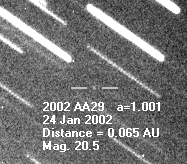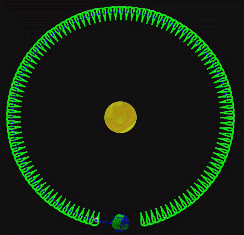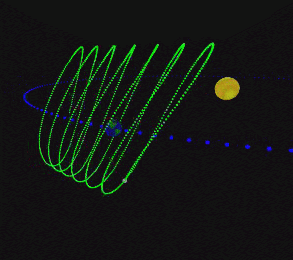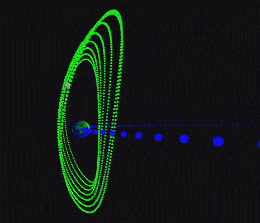Earth coorbital asteroid 2002 AA29
Martin Connors
Centre for Science, Athabasca University, Athabasca AB CANADA
Paul Chodas
Jet Propulsion Laboratory, California Institute of Technology, Pasadena CA USA
Seppo Mikkola
Tuorla Observatory, University of Turku FINLAND
Paul Wiegert
Dept. of Physics, The University of Western Ontario, London ON CANADA
Christian Veillet
Canada-France-Hawaii Telescope, Kamuela HI USA
Kimmo Innanen
Dept. of Physics and Astronomy, York University, Toronto ON CANADA
Press release
September 2002
An international team of astronomers has found that an asteroid
discovered earlier this year follows Earth's orbit around the Sun and
will, in nearly 600 years, appear to orbit the Earth. In the October
issue of the journal Meteoritics and Planetary Science, the
astronomers announce that the asteroid, named 2002 AA29, follows a
"horseshoe orbit" that makes it come near the Earth every 95 years. It
will next come close on January 8, 2003, although even then it will be
much further away than the Moon and only detectable using large
telescopes. The combination of Earth's and Sun's gravity works so that
even as Earth pulls in the asteroid, it speeds up and moves away from
the Earth. In this way Earth is protected from impact, despite the
similarity of the asteroid's orbit to Earth's.
The special horseshoe orbit was pointed out by Paul Chodas of the Jet
Propulsion Laboratory in Pasadena to Martin Connors of Athabasca
University in Canada, shortly after the object was discovered in
January by the LINEAR asteroid survey. Connors, then on leave in
California, alerted colleagues at Queen's University in Kingston,
Ontario, York University in Toronto, and the Tuorla Observatory in
Finland. Rapid calculations confirmed the special nature of the orbit,
and followup observations were taken by Christian Veillet with the
large Canada-France-Hawaii telescope. "Most of us had worked together
to search for objects closely related to this one, so our team was
ready to spring into action", states Connors. Besides finding that the
object would come close to Earth next year and then move around
Earth's orbit to come back in 2098, the team found that in about 600
years, the asteroid will become a "quasi-satellite" of the
Earth. While Earth has only one natural satellite, the Moon, for about
fifty years this small asteroid will move near the Earth and appear to
be in orbit, going around once a year. In fact, explains team member
Paul Wiegert of Queen's University, "both the Earth and the asteroid
still both go around the Sun, but the relative looping motion of the
asteroid in some ways resembles a satellite orbit, with an apparent
period of one year". Calculations by Seppo Mikkola in Finland suggest
that the asteroid has already been a quasi-satellite, from about 550
to 600 A.D., but since it is such a small object it would not have
been seen then.
The vast majority of asteroids are in belt between the planets Mars
and Jupiter, thus rather far from the Earth. Even near-Earth
asteroids, that sometimes cause a panic when they fly by, usually have
orbits reaching out to the asteroid belt. Coorbital asteroids similar
in some ways to 2002 AA29 are known to follow Jupiter's orbit and
Mars' orbit, but this is the first one known for Earth. Some asteroids
are known to have a similar interplay with Earth's gravity, but do not
follow our orbit as closely as does 2002 AA29. Wiegert, Mikkola, and
Innanen found the first such object, called Cruithne, in the
mid-1990s, but its orbit is very stretched out. The orbit of 2002 AA29
is very round like Earth's, but slightly tilted. An orbit similar to
Earth's makes a body easy to reach with spacecraft. The scientists
hope to use 2002 AA29 as an example showing that asteroids moving
along Earth's orbit do exist, so that they can search for other
asteroids with orbits even more similar to ours. Such asteroids could
be good targets for space missions and could even be sources of raw
materials in space. These special asteroids will likely be hard to
find but fascinating. As team member Kimmo Innanen says, "Mother
Nature keeps showing us that her repertoire is more bountiful than we
thought!"
More on Earth Coorbital Asteroids
What we call "Earth coorbital asteroids" (or ECAs) here are asteroids
in a 1:1 mean-motion resonance with the Earth. That means that they go
around the Sun in the same amount of time as the Earth does, that is,
one year. Though the Earth and the asteroids don't always move at the
same speed at every instant, their average (or mean) motion is the
same, hence the name 1:1 mean-motion resonance.
The best known cases of this resonance are the Trojan asteroids of
Jupiter. Over 400 hundred asteroids remain stable either approximately
60 degrees ahead of or behind Jupiter as it goes around its orbit;
both planet and asteroids take 11.86 years to circle the Sun. The
Earth may also have similar bodies (Earth Lagrange point asteroids)
though none are yet known.
Earth companion asteroids are bodies in 1:1 mean motion resonance,
though are not necessarily confined ahead of or behind our planet the
way Trojans are. Nonetheless, they are not just coincidentally in our
vicinity in the way most Near-Earth asteroids are. ECAs share a
specific though subtle kind of dynamical relationship with the
Earth.
What makes asteroid 2002 AA29 especially interesting?
 Asteroid 2002 AA29 was discovered by the LINEAR asteroid search
program in January 2001. Shortly after this, the coorbital nature of
the orbit of 2002 AA29 was pointed out by Martin Connors (Athabasca U)
and Paul Chodas (JPL). A follow-up image, taken by Kyle Smalley with
the 0.75 meter telescope at the Astronomical Society of Kansas City's
Powell Observatory,
is shown on the left. The image is composed of sequential exposures
which were "stacked" so that asteroid is in the same spot in them all.
Since the asteroid moves against the background stars from exposure to
exposure, the stacking results in the stars getting smeared out into
long tracks across the image. The bars indicate the position of the
faint asteroid 2002 AA29. It was 0.065 AU (astronomical units, equal
to the distance between the Earth and the Sun) or about 10 million km
away from Earth when this was taken. Note: other faint dots on the
image are not asteroids, but glitches due to cosmic rays hitting the
detector.
Asteroid 2002 AA29 was discovered by the LINEAR asteroid search
program in January 2001. Shortly after this, the coorbital nature of
the orbit of 2002 AA29 was pointed out by Martin Connors (Athabasca U)
and Paul Chodas (JPL). A follow-up image, taken by Kyle Smalley with
the 0.75 meter telescope at the Astronomical Society of Kansas City's
Powell Observatory,
is shown on the left. The image is composed of sequential exposures
which were "stacked" so that asteroid is in the same spot in them all.
Since the asteroid moves against the background stars from exposure to
exposure, the stacking results in the stars getting smeared out into
long tracks across the image. The bars indicate the position of the
faint asteroid 2002 AA29. It was 0.065 AU (astronomical units, equal
to the distance between the Earth and the Sun) or about 10 million km
away from Earth when this was taken. Note: other faint dots on the
image are not asteroids, but glitches due to cosmic rays hitting the
detector.
 These can be differentiated from real objects by examining the image
at higher resolution than seen here. To view the time-lapse path of
2002 AA29 gliding past distant galaxies, check out this animation of images taken by Christian
Veillet at the Canada-France-Hawaii Telescope. 2002 AA29 is the fuzzy
dot that can be seen drifting along against the background stars (the line
it moves along was added in post-processing). The two brightest blobs
are galaxies that happen to be in the same field of view. What looks
like another asteroid passing through the upper left corner of some of
the frames is not real, just a by-product of the way the frames were
processed.
These can be differentiated from real objects by examining the image
at higher resolution than seen here. To view the time-lapse path of
2002 AA29 gliding past distant galaxies, check out this animation of images taken by Christian
Veillet at the Canada-France-Hawaii Telescope. 2002 AA29 is the fuzzy
dot that can be seen drifting along against the background stars (the line
it moves along was added in post-processing). The two brightest blobs
are galaxies that happen to be in the same field of view. What looks
like another asteroid passing through the upper left corner of some of
the frames is not real, just a by-product of the way the frames were
processed.
Most of the time, the path of asteroid 2002 AA29 looks as shown
to the right. Note that we are looking at the asteroid from above the Sun,
and in a frame which moves along with the Earth, which remains
stationary at the bottom of the frame (for an animated view, see the
MPEG movie clip).
When seen in this frame, the reason for the name "horseshoe orbit"
becomes apparent. The asteroid loops along the Earth's orbit, but
reverses direction when it approaches our planet from either
side. This phenomena is a result of the 1:1 mean-motion
resonance. Each loop takes one year to complete; and it takes 95 loops
(years) for 2002 AA29 to go from one end of the horseshoe to the
other. A fuller explanation of horseshoe orbits can be found on the
3753 Cruithne page.
 However, for part of the time, 2002 AA29 goes into quasi-satellite
mode. At this time, instead of avoiding the vicinity of the Earth,
the asteroid's motion is restricted there. Instead of covering the
whole horseshoe orbit, the asteroid becomes temporarily "trapped" in
the horseshoe's gap. To the left, we see a three-quarters perspective
view of the motion of 2002 AA29 at this time. Note the Earth, rather
faint in this image, in the middle of the asteroid's loops, and the Sun
in the background. The blue dots outline the Earth's orbit.
However, for part of the time, 2002 AA29 goes into quasi-satellite
mode. At this time, instead of avoiding the vicinity of the Earth,
the asteroid's motion is restricted there. Instead of covering the
whole horseshoe orbit, the asteroid becomes temporarily "trapped" in
the horseshoe's gap. To the left, we see a three-quarters perspective
view of the motion of 2002 AA29 at this time. Note the Earth, rather
faint in this image, in the middle of the asteroid's loops, and the Sun
in the background. The blue dots outline the Earth's orbit.
During this time, the asteroid remains, properly speaking, in orbit
around the Sun. Asteroid 2002 AA29 travels once around the Sun each
year, as does the Earth. However, since the planet and asteroid orbit
in the same amount of time, they remain close to each other throughout
their journey. An analogy would be two cars (the planet and the
asteroid) traveling with near-equal speeds around a circular race
track (their orbit around the Sun).
 Both cars will remain near each other because of their similar
velocities without there necessarily being any physical connection
(eg. strong gravity) between them. An MPEG clip shows the motion in more detail.
Both cars will remain near each other because of their similar
velocities without there necessarily being any physical connection
(eg. strong gravity) between them. An MPEG clip shows the motion in more detail.
To the right is another view, this time looking along the Earth's
orbit. The Sun is off the image to the right here. We see that, though
trapped in the neighbourhood of our planet, 2002 AA29 loops safely around us.
Because there are slight differences between the velocities of Earth and 2002 AA29,
they do not remain completely stationary with respect to one another. Rather, the
asteroid drifts slightly and as a result, loops around our planet over the
course of a year. Hence the name "quasi-satellite". You can learn more
about this kind of behaviour at our quasi-satellite page.
After a while, 2002 AA29 will escape from quasi-satellite mode and go
back to horseshoe mode. The last period of quasi-satellite motion was
in about 550 A.D.; the next will be in 2600 A.D. or so. This ability
to make the transition from horseshoe to quasi-satellite motion is
part of what makes 2002 AA29 so interesting: no other asteroids are
known to do this. It also has a very low eccentricity e (only
0.012 at discovery, less even than the Earth's very small 0.0167)
compared to the average of 0.29 for near-Earth asteroids in
general. As a result, its orbit is almost circular, and matches the
shape of the Earth's closely. It is the tilt or inclination
i of 2002 AA29, a modest 10 degrees, that keeps the two objects
orbits apart; otherwise they would lie almost on top of each
other. The effect of the small eccentricity and more substantial
inclination can be seen in the images above. They result in the
asteroid's loops being elongated in the up-down direction (due to i)
but narrow across the middle (due to the small e).
Want to know more?
The discovery paper in PDF format, as accepted for publication in the journal Meteoritics and Planetary Science.
Video clips
Note: the following clips (and the previous
images) are only illustrative of the orbits involved. In particular,
the number of "loops" has been reduced for easier visibility, and the
sizes of the Sun, Earth and the asteroid have been exaggerated for the
same reason. As a result, the asteroid appears to pass much closer to
the Earth than it does in reality.
Horseshoe orbit
An MPEG clip
(2.3 Mb) of the motion of 2002 AA29 in horseshoe mode.
A higher resolution clip (4.5 Mb) is available here
The view from Earth
An MPEG clip
(1.7 Mb) of the motion of 2002 AA29 as it approaches one end of the horseshoe, as seen looking along
the Earth's orbit.
Quasi-satellite
An MPEG clip
(2.7 Mb) clip of the motion of 2002 AA29 in quasi-satellite mode.
A higher resolution clip (4.5 Mb) is available here
Other miscellaneous images:
 One A view of 2002 AA29 approaching Earth along
its horseshoe orbit
One A view of 2002 AA29 approaching Earth along
its horseshoe orbit
 Two A similar view, but with a realistic density of loops. It takes 95 years(=loops) to go from one end of the horseshoe to the other.
Two A similar view, but with a realistic density of loops. It takes 95 years(=loops) to go from one end of the horseshoe to the other.
Related links
3753 Cruithne, the Earth's first coorbital asteroid
Could there be asteroids at the Earth's Lagrange points?
What's kinda like a satellite, but isn't? Check out our
quasi-satellite page.
Have a question or comment? Contact me ( Paul Wiegert at pwiegert[the @ sign]uwo.ca)
Earth coorbital asteroid 2002 AA29 page
© Copyright 2002-2021 by Paul Wiegert
 Asteroid 2002 AA29 was discovered by the LINEAR asteroid search
program in January 2001. Shortly after this, the coorbital nature of
the orbit of 2002 AA29 was pointed out by Martin Connors (Athabasca U)
and Paul Chodas (JPL). A follow-up image, taken by Kyle Smalley with
the 0.75 meter telescope at the Astronomical Society of Kansas City's
Powell Observatory,
is shown on the left. The image is composed of sequential exposures
which were "stacked" so that asteroid is in the same spot in them all.
Since the asteroid moves against the background stars from exposure to
exposure, the stacking results in the stars getting smeared out into
long tracks across the image. The bars indicate the position of the
faint asteroid 2002 AA29. It was 0.065 AU (astronomical units, equal
to the distance between the Earth and the Sun) or about 10 million km
away from Earth when this was taken. Note: other faint dots on the
image are not asteroids, but glitches due to cosmic rays hitting the
detector.
Asteroid 2002 AA29 was discovered by the LINEAR asteroid search
program in January 2001. Shortly after this, the coorbital nature of
the orbit of 2002 AA29 was pointed out by Martin Connors (Athabasca U)
and Paul Chodas (JPL). A follow-up image, taken by Kyle Smalley with
the 0.75 meter telescope at the Astronomical Society of Kansas City's
Powell Observatory,
is shown on the left. The image is composed of sequential exposures
which were "stacked" so that asteroid is in the same spot in them all.
Since the asteroid moves against the background stars from exposure to
exposure, the stacking results in the stars getting smeared out into
long tracks across the image. The bars indicate the position of the
faint asteroid 2002 AA29. It was 0.065 AU (astronomical units, equal
to the distance between the Earth and the Sun) or about 10 million km
away from Earth when this was taken. Note: other faint dots on the
image are not asteroids, but glitches due to cosmic rays hitting the
detector.
 These can be differentiated from real objects by examining the image
at higher resolution than seen here. To view the time-lapse path of
2002 AA29 gliding past distant galaxies, check out this animation of images taken by Christian
Veillet at the Canada-France-Hawaii Telescope. 2002 AA29 is the fuzzy
dot that can be seen drifting along against the background stars (the line
it moves along was added in post-processing). The two brightest blobs
are galaxies that happen to be in the same field of view. What looks
like another asteroid passing through the upper left corner of some of
the frames is not real, just a by-product of the way the frames were
processed.
These can be differentiated from real objects by examining the image
at higher resolution than seen here. To view the time-lapse path of
2002 AA29 gliding past distant galaxies, check out this animation of images taken by Christian
Veillet at the Canada-France-Hawaii Telescope. 2002 AA29 is the fuzzy
dot that can be seen drifting along against the background stars (the line
it moves along was added in post-processing). The two brightest blobs
are galaxies that happen to be in the same field of view. What looks
like another asteroid passing through the upper left corner of some of
the frames is not real, just a by-product of the way the frames were
processed. 

